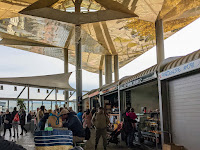Irene found an exhibit of some of the video works of Bruce Conner here in Barcelona at an event called "Autumn Vermouths" (in English). It's at the Antoni Tàpies Foundation building, just a 17 minute walk away. When I looked it up, I realized I'd walked past the building in 2017 and wondered about it: on top of this ornate building was a mass of twisted wire, screen, and rebar; I couldn't decide if it was construction, demolition, or art.
In the context of artist Tàpies, it makes sense: he celebrated found objects, every day objects, and largely pioneered the movement in connection with Duchamp and others. And today, we got to visit it and check out the art inside!
The building itself was gorgeous inside, mixing wide open museum-style spaces, industrial iron, and a beautiful wood-and-glass-encased library for researchers.
For only 10€ we got a guided tour of the Antoni Tápies exhibit "The Fertilizer that Feeds the Soul". I didn't know anything about him, but he was a pioneer in treating everyday objects and found objects in the context of art. Our guide was enthusiastic and knowledgeable but unfortunately, we didn't understand much as she gave the guided tour in Catalan; totally our fault, and we contented ourselves by reading the English labels.
Afterwards, there was a reception on the attractive roof deck, where we could see from behind the mass of wires on the façade, as well as a sculpture of a giant sock -- a recurring element in his work, it turns out. And of course the promised vermut with snacks of potato chips and anchovy-stuffed olives.
Irene worked up the courage to tell her we didn't understand anything, and this broke the ice to a conversation (in our stilted Spanish) about Tápies, Bruce Conner, and modern art in general.
After the break, we went downstairs to check out the Bruce Conner exhibit "Light out of Darkness". I've been interested in Conner since 1987 when I saw a piece of his at a collector's shop in Georgetown DC, obsessed over it, and finally purchased the lithograph. I've been fortunate to see a lot of his work including films, assemblages, mixed media, and prints in DC at the Smithsonian's Hirshhorn and Katzen Arts Center, and in San Francisco at the SF MOMA and DeYoung Museum. Our guide indicated this was the first time Conner's video work has been exhibited in Barcelona. Some of the pieces I'd seen before, including early (MTV-era) videos for Devo and Talking Heads, but also films focusing on the atomic bomb tests and Kennedy's assassination set to music by Terry Riley. You can see how he pioneered the fast cuts, video overdubs, and other techniques we now take for granted. If you blow up the text in the second image about his video for David Byrne and Brian Eno's "Mea Culpa", it's pretty damning:
"Although copyright reasons prevented Conner's films from being played on MTV, the film techniques he employed -- the jump cut, flash frame, flickering, reverse editing, fast cutting, double and multiple exposures and the use of found footage -- had a formative influence on just on the experimental film-making of his age, but also on the pioneering phase of the MTV music video"
I'd never heard of the third artist, Tekla Aslanishvili from Georgia but really enjoyed her documentary video "A State in a State". It draws a connection of communication and solidarity between railroad workers from major transport lines including Azerbijan, Georgia, Turkey, Belarus, and Ukraine, before and after the breakup of the USSR. It winds up in the present day with workers agreeing to sabotage lines critical to Russia's current war effort. Her style reminded me of Werner Herzog's documentary work a little, and I was surprised how much I enjoyed learning about conflicts and places I'd only heard about on the radio growing up.
This event has whetted my appetite to get out and explore more culture, especially modern art, in this rich city.



























































